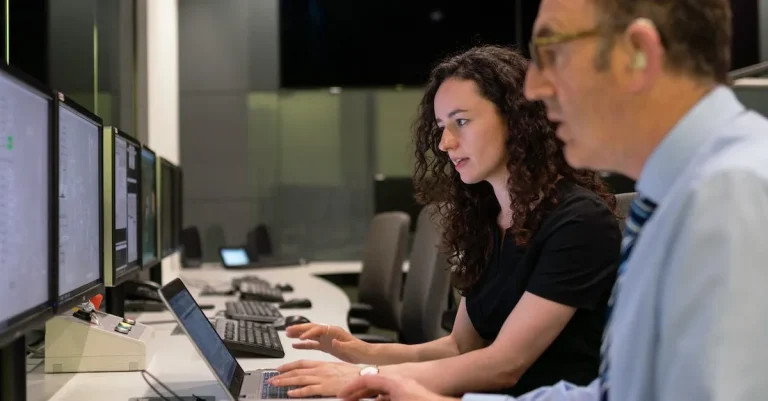10 Creative Ap Computer Science Principles Project Ideas
A key part of the AP Computer Science Principles course is completing a digital project. This allows students to demonstrate their coding skills and computing knowledge creatively. Coming up with an interesting project idea can be challenging.
If you’re short on time, here are some quick AP CS Principles project ideas: mobile apps, games, simulations, productivity tools, creative coding art, social media analysis, cybersecurity programs, machine learning applications, website/app prototypes, and assistive technology.
This article explores 10 unique and engaging project ideas to help jumpstart your AP Computer Science Principles creation.
Build a Mobile App
Building a mobile app can be an exciting and challenging project for AP Computer Science Principles. It allows you to apply your coding skills and creativity to develop a functional and user-friendly application that can be used on smartphones and tablets.
When choosing a project idea, consider whether you want to create a helpful utility app or an engaging game.
Helpful utility app or engaging game
If you decide to create a helpful utility app, think about the everyday problems that people face and how you can provide a solution through your app. For example, you could develop a budgeting app to help users track their expenses and manage their finances more effectively.
Alternatively, you could create a language learning app that makes it fun and interactive for users to practice vocabulary and grammar.
On the other hand, if you prefer to build an engaging game, think about the type of game that you enjoy playing and how you can put your own spin on it. Maybe you could create a puzzle game that challenges players to solve intricate riddles or a multiplayer strategy game that allows users to compete against each other in a virtual world.
The possibilities are endless!
Use Java/Android Studio or Swift/Xcode
When it comes to coding a mobile app, you have a couple of options depending on the platform you choose. If you decide to develop your app for Android devices, you can use Java programming language and Android Studio, which is a popular integrated development environment (IDE) for Android app development.
On the other hand, if you prefer to build an app for iOS devices, you can utilize Swift programming language and Xcode, the official IDE for iOS app development. Swift is known for its simplicity and power, making it a great choice for creating sleek and intuitive apps for iPhones and iPads.
Remember, building a mobile app requires careful planning, coding, and testing. Be sure to break down your project into smaller tasks, set realistic deadlines, and continuously test and refine your app as you go.
Don’t be afraid to seek out online resources and tutorials to enhance your skills and overcome any challenges you encounter along the way.
Develop an Interactive Game
Creating an interactive game is a great way to apply your programming skills and engage users with an entertaining experience. Whether you choose to develop a fun arcade, board, or puzzle game, the possibilities are endless.
Not only will you have the opportunity to showcase your creativity, but you can also challenge yourself to incorporate complex algorithms and problem-solving techniques.
Fun arcade, board, or puzzle game
When it comes to developing a game, the genre you choose is entirely up to you. You can create a fast-paced arcade game that tests the player’s reflexes, a strategic board game that requires careful planning, or a mind-boggling puzzle game that stimulates critical thinking.
The key is to design a game that is enjoyable and keeps the players hooked for hours.
For inspiration, you can look at popular games like “Angry Birds” or “Tetris” and put your own unique twist on them. Consider incorporating a scoring system, power-ups, or different levels of difficulty to make the game more engaging and challenging.
Use Unity or JavaScript canvas
When it comes to game development, you have various tools and frameworks at your disposal. Two popular options are Unity and JavaScript canvas.
Unity is a powerful game engine that allows you to create both 2D and 3D games. It provides a user-friendly interface and a wide range of features and assets to help you bring your game to life. With Unity, you can easily add animations, physics, and sound effects to enhance the overall gaming experience.
If you prefer a more lightweight approach, you can use JavaScript canvas. This HTML5 element allows you to draw graphics and create interactive elements directly on your web page. It is a versatile option that enables you to build browser-based games that can be played across different devices.
Both Unity and JavaScript canvas have extensive documentation and online communities that can help you overcome any challenges you may encounter during the development process.
Remember, the goal of developing an interactive game is to not only entertain but also showcase your technical skills and creativity. Don’t be afraid to push the boundaries and try innovative ideas to make your game stand out!
Code a Computer Simulation
One creative project idea for AP Computer Science Principles is to code a computer simulation. This project allows students to apply their programming skills to create virtual environments that mimic real-world interactions and behaviors.
By coding simulations, students can gain a deeper understanding of various subjects while also honing their coding abilities.
Physics, biology, social science, or abstract systems
When coding a computer simulation, students have the flexibility to choose a subject that interests them. They can create simulations related to physics, biology, social science, or even abstract systems.
For example, a student interested in physics can create a simulation to model the motion of objects under the influence of various forces. Similarly, a biology enthusiast can design a simulation to showcase the behavior of populations of animals or simulate the growth of a plant.
By choosing a subject that aligns with their interests, students can dive deeper into the concepts and gain a better understanding of how these systems work. Additionally, this project allows students to think critically and creatively about how to effectively represent real-world phenomena through code.
Model real-world interactions and behaviors
One of the main goals of coding a computer simulation is to model real-world interactions and behaviors. For instance, a student interested in social science can create a simulation that simulates the spread of a contagious disease in a population.
This can provide insights into the effectiveness of different intervention strategies, such as vaccination or social distancing measures.
By modeling complex systems and their interactions, students can explore cause-and-effect relationships and analyze the impact of different variables on the overall system. This helps develop critical thinking skills and provides a hands-on approach to understanding real-world phenomena.
There are various programming languages and tools available for coding computer simulations, such as Python, Java, or specialized simulation software like NetLogo. Students can leverage online resources and tutorials to learn the necessary skills and techniques to bring their simulations to life.
Design a Productivity Tool
Scheduling Assistant, Notes App, Budget Planner
When it comes to designing a productivity tool for your AP Computer Science Principles project, the possibilities are endless. One idea is to create a scheduling assistant that helps users manage their time effectively.
This tool could allow users to input their daily tasks and deadlines, and then generate a schedule that optimizes their productivity. Another idea is to develop a notes app that helps users organize their thoughts and ideas.
This app could include features like categorization, tagging, and search functionality to make it easy for users to find specific notes. Lastly, you could design a budget planner that helps users track their income and expenses.
This tool could generate visualizations and provide suggestions on how to save money.
Solve Personal Organization Problems
Designing a productivity tool that solves personal organization problems can be a great way to showcase your coding skills. Think about common challenges people face when it comes to staying organized and create a tool that addresses those issues.
For example, you could develop a task manager that allows users to prioritize their to-do lists and set reminders for important tasks. Another idea is to create a habit tracker that helps users build and maintain good habits.
This tool could provide visualizations of progress and send reminders to keep users on track. By focusing on solving real-life problems, you can create a project that is both practical and innovative.
Looking for inspiration or need help getting started? Check out websites like Todoist, Evernote, and Mint to see how existing productivity tools are designed and what features they offer. Remember to put your own unique spin on your project to make it stand out!
Generate Creative Coding Art
Artistic animations, patterns, fractals
One way to explore the creative potential of coding is by creating artistic animations, patterns, and fractals. With the use of programming languages like Python or JavaScript, you can write code that generates mesmerizing visuals.
By manipulating variables, loops, and mathematical formulas, you can create animations that come to life on your screen. From colorful patterns that change and evolve over time to intricate fractal designs, the possibilities are endless.
You can experiment with different algorithms and parameters to create unique and visually stunning artwork.
For inspiration and guidance on creating coding art, websites like OpenProcessing.org provide a platform for coders to share their artistic creations. You can explore the gallery of projects, analyze the code behind them, and even remix them to add your own touch.
This not only allows you to learn from others but also encourages collaboration and creativity within the coding community.
Explore coding’s artistic potential
Coding is not just about solving problems or building functional applications. It can also be a powerful tool for artistic expression. By combining programming concepts with your imagination, you can create digital artwork that pushes boundaries and challenges traditional notions of art.
The fusion of technology and creativity opens up a world of possibilities, allowing you to create interactive installations, generative art, or even virtual reality experiences.
To delve deeper into the intersection of coding and art, websites like CreativeApplications.net offer a wealth of resources and inspiration. You can explore articles, interviews, and showcases of innovative projects that explore the artistic potential of coding.
The website covers a wide range of topics, from interactive installations to data visualization, providing a glimpse into the diverse ways in which coding can be used to create captivating art.
So, if you’re looking to unleash your creativity and explore the artistic side of coding, don’t be afraid to experiment, learn from others, and let your imagination run wild. With the right tools and mindset, you can create coding art that is not only visually stunning but also thought-provoking and inspiring.
Analyze Social Media Data
Social media has become a treasure trove of information, and analyzing this data can provide valuable insights for various purposes. In the field of AP Computer Science Principles, analyzing social media data can be a fascinating project idea that allows students to apply their programming skills to real-world scenarios.
Mine platforms like Twitter for insights
One project idea is to mine social media platforms like Twitter to gain insights into user behavior, trends, and preferences. By utilizing APIs and programming languages like Python, students can extract and analyze data such as the number of tweets, retweets, and likes for a particular hashtag or topic.
They can also delve into user demographics, language usage, and geographical distribution. This kind of analysis can provide valuable information for businesses, marketers, and researchers to understand public opinion and target their audience effectively.
Sentiment analysis, trend identification
Another interesting project idea is sentiment analysis and trend identification on social media platforms. Students can develop algorithms that analyze the sentiment of tweets or posts, categorizing them as positive, negative, or neutral.
This information can help understand public sentiment towards specific topics or events. Moreover, students can identify trending topics or hashtags by analyzing the frequency and popularity of certain keywords or phrases on social media platforms.
This kind of analysis can be helpful for businesses and individuals to stay updated with the latest trends and monitor their online reputation.
There are various resources and libraries available online that can assist students in analyzing social media data. Tools like Tweepy, TextBlob, and NLTK provide functionalities specifically designed for mining and analyzing social media data.
Additionally, websites like Twitter Developer API provide documentation and guidelines for extracting data from Twitter.
By tackling projects that involve analyzing social media data, students not only enhance their programming skills but also gain insights into the vast amount of information available on social media platforms.
This kind of project allows them to explore the intersection of technology and human behavior, making it a great choice for AP Computer Science Principles.
Build Cybersecurity Programs
Cybersecurity is a critical aspect of computer science today, as more and more sensitive information is stored and transmitted online. Building cybersecurity programs can be an exciting and challenging project idea for AP Computer Science Principles students.
By working on this project, students can gain a deeper understanding of encryption, authentication, and security analysis.
Encryption, Authentication, Security Analysis
One aspect of building cybersecurity programs is understanding encryption. Encryption is the process of converting data into a format that is unreadable to unauthorized individuals. Students can explore different encryption algorithms, such as RSA or AES, and learn how to implement them in their programs.
Authentication is another crucial component of cybersecurity. It involves verifying the identity of users or systems before granting access to sensitive information. Students can develop authentication mechanisms, such as username/password combinations or biometric authentication, to ensure the security of their programs.
Security analysis is an integral part of building cybersecurity programs. Students can learn how to identify vulnerabilities in their programs and implement measures to mitigate potential risks. By conducting thorough security analysis, students can ensure that their programs are robust and resistant to attacks.
Test Strengths and Weaknesses
Once the cybersecurity program is built, it is essential to test its strengths and weaknesses. Students can simulate different hacking scenarios and evaluate how their programs hold up against various attacks.
They can analyze the effectiveness of their encryption algorithms and authentication mechanisms under different conditions.
By testing the strengths and weaknesses of their cybersecurity programs, students can gain valuable insights into the vulnerabilities that exist and improve their programs accordingly. This project allows students to develop critical thinking and problem-solving skills as they analyze and address potential security loopholes.
It is important for students to stay updated with the latest cybersecurity trends and best practices. Websites like us-cert.gov or cisa.gov provide valuable resources and information on cybersecurity. Students can refer to these authoritative sources to enhance their knowledge and make their cybersecurity programs even more robust.
Create Machine Learning Tools
Image recognition, predictive text, data clustering
Machine learning has revolutionized various industries by enabling computers to learn from data and make predictions or decisions. In the field of computer science, machine learning can be applied to a wide range of projects. One exciting project idea is to create an image recognition tool.
This tool can be trained to identify objects or patterns within images, making it useful for applications such as facial recognition, object detection, and even medical imaging analysis.
Another interesting project idea is to develop a predictive text tool. This tool can use natural language processing techniques to analyze a user’s input and suggest the next word or phrase based on context.
It can be used in various applications, such as improving the accuracy of autocomplete functionality in messaging apps or assisting in writing tools.
Data clustering is another fascinating area to explore in machine learning. This technique involves grouping similar data points together based on their characteristics. It can be applied to various domains, such as customer segmentation for targeted marketing or analyzing patterns in large datasets.
Creating a data clustering tool can provide valuable insights and help in decision-making processes.
Leverage AI and neural networks
Artificial intelligence (AI) and neural networks are at the forefront of cutting-edge technology. By leveraging these powerful tools, you can create innovative projects in AP Computer Science Principles. One idea is to build an AI-powered chatbot.
This chatbot can be trained to understand and respond to user queries, providing a personalized and interactive experience. It can be integrated into websites, mobile apps, or messaging platforms.
Another project idea is to develop a neural network-based recommendation system. This system can analyze user preferences and behavior to make personalized recommendations, such as suggesting movies, books, or products.
It can enhance the user experience and help users discover new content based on their interests.
When working on these machine learning projects, it’s essential to have a good understanding of algorithms, data preprocessing techniques, and model evaluation. Learning about popular machine learning libraries like TensorFlow, Scikit-learn, or Keras can also be beneficial.
For more in-depth information and examples of machine learning projects, you can visit websites like TensorFlow.org or Scikit-learn.org. These resources provide tutorials, code samples, and documentation to help you get started on your exciting AP Computer Science Principles project.
Prototype an App or Website
Prototyping an app or website is an essential step in the development process. It allows developers to create a visual representation of their ideas before diving into coding. This step helps in refining the overall design, structure, and functionality of the final product.
Develop wireframes and workflow
Wireframes are basic, simplified layouts that outline the structure of an app or website. They serve as a blueprint for developers and designers to understand how different components will fit together. Creating wireframes helps in visualizing the overall flow and navigation of the app or website.
There are various tools available, such as Figma, Sketch, or Adobe XD, that can assist in creating wireframes and workflow diagrams.
Simulate appearance and functionality
Once the wireframes are ready, developers can move on to creating a prototype that simulates the appearance and functionality of the app or website. This is done using interactive design tools or development frameworks such as InVision, Marvel, or Flutter.
Prototyping allows developers to test the user interface, user experience, and overall functionality of the app or website, making it easier to identify and address any potential issues early on.
By prototyping an app or website, developers can gather feedback from users and stakeholders, iterate on the design, and ensure a smoother development process. It also helps in aligning the vision of the project with the desired outcome, making it a crucial step in the creation of any successful digital product.
Design Assistive Technology
Designing assistive technology is an exciting and impactful project idea for AP Computer Science Principles. Assistive technology refers to devices, software, or apps that are specifically designed to help people with disabilities overcome various challenges and improve their quality of life.
Apps for accessibility, independent living, health
One way to approach this project is by developing apps that promote accessibility, independent living, and health for individuals with disabilities. These apps can provide features such as voice recognition, braille support, or visual aids to assist individuals with visual impairments.
They can also incorporate reminders for medication management, exercise routines, or nutrition tracking to support better health and well-being.
An example of an app in this category is “BeMyEyes,” which connects blind or visually impaired individuals with sighted volunteers who can assist them through live video calls. This app allows blind users to get help with tasks such as reading labels, identifying objects, or navigating unfamiliar environments, greatly enhancing their independence and daily functioning.
Help people with disabilities
Another approach to designing assistive technology is to create devices or software that directly help people with disabilities overcome specific challenges. For instance, you could develop a device that uses sensors and machine learning algorithms to detect epileptic seizures and automatically trigger an alert system to notify caregivers or medical professionals.
This technology could potentially save lives by providing timely assistance during critical situations.
Additionally, you could explore the development of exoskeletons or prosthetic limbs that utilize advanced robotics and AI to improve mobility and enhance the capabilities of individuals with physical disabilities.
These technologies have the potential to revolutionize the lives of individuals with mobility impairments, allowing them to regain independence and participate more fully in daily activities.
When working on a project like this, it’s important to consider the specific needs and challenges faced by people with disabilities. Collaborating with organizations and individuals in the field can provide valuable insights and ensure that your project is addressing real-world problems.
Websites like Disabled World or Access Board can provide additional information and resources to guide your project.
Conclusion
AP Computer Science Principles projects offer lots of possibilities to showcase your programming skills creatively. Building mobile apps, games, simulations, art, and tools can help make your project unique. Focus on an idea that aligns with your interests and skills for the best experience.







